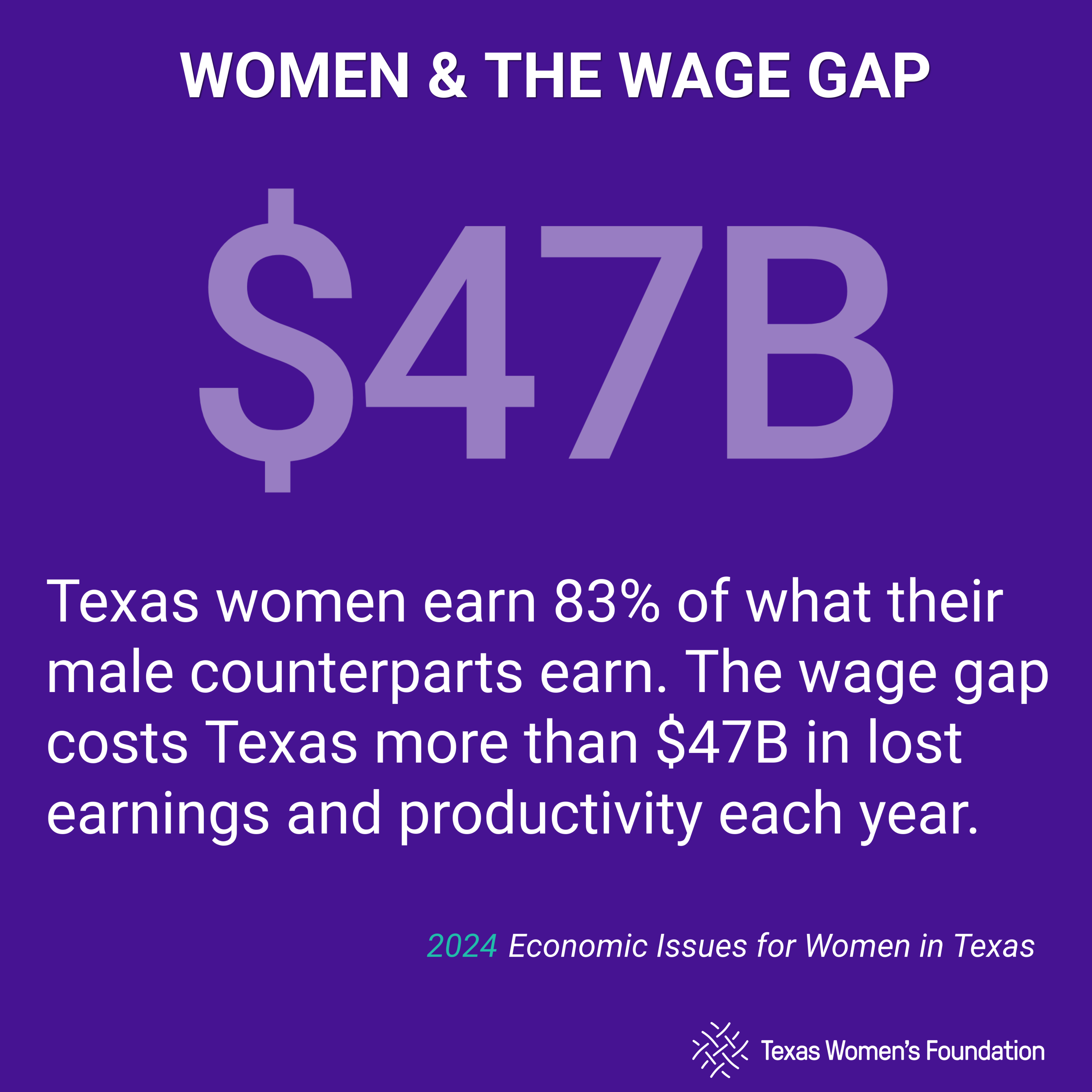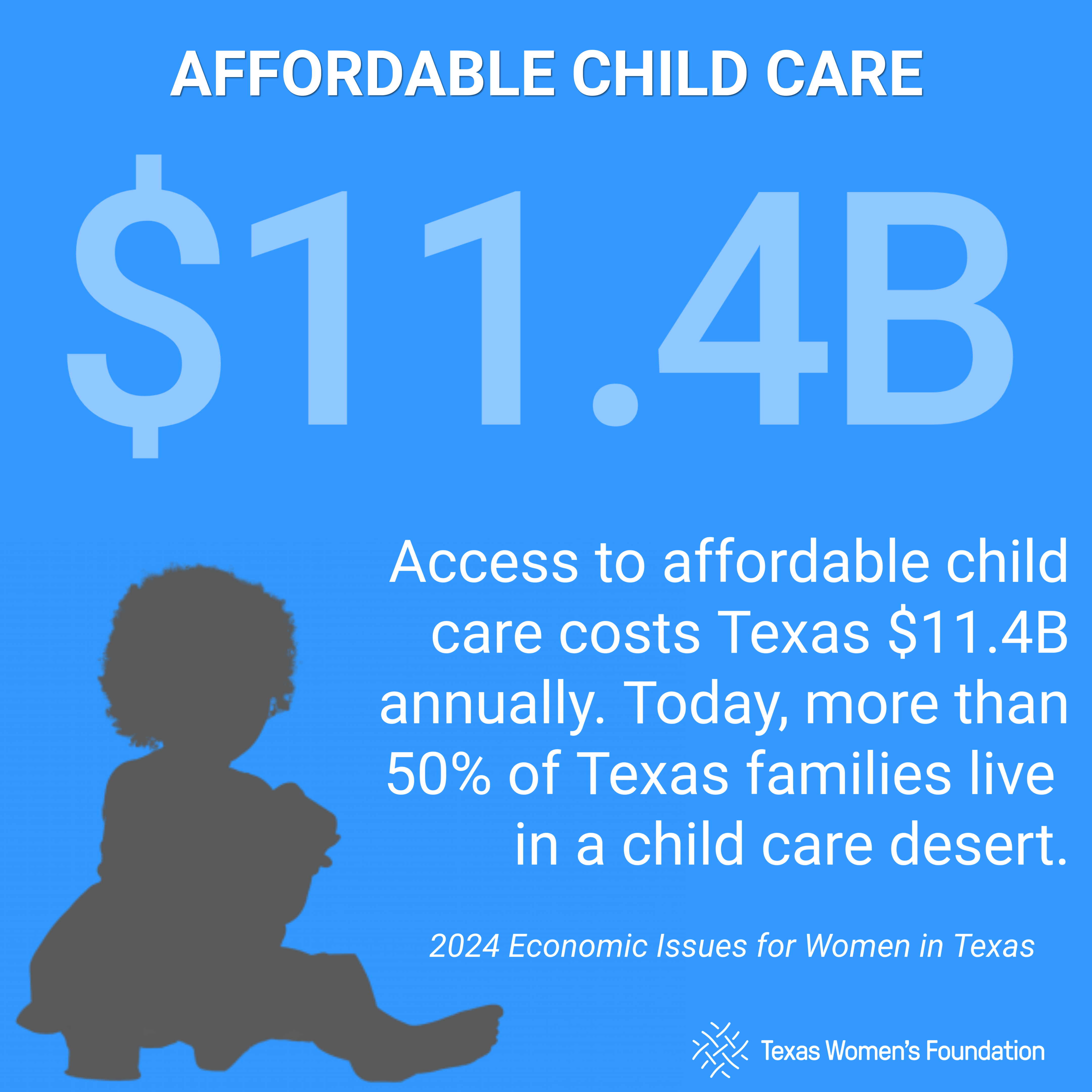Texas has the highest percentage of uninsured women in the nation – 17 percent. More than 15 percent of women in Texas live in poverty, more than the national average.
![TWF-alt-cover-photo (1)[28]](https://focusntx.com/wp-content/uploads/2024/12/TWF-alt-cover-photo-128-1024x576.png)
Courtesy photo from Texas Women’s Foundation
Texas has one of the strongest economies in the nation and is ranked the eighth-largest economy in the world. A big contributing factor is the increasing number of working women who comprise 46 percent of the state’s workforce and are helping to drive economic growth and innovation. Yet, despite women’s contributions to the economy, Texas ranks just 47th out of 50 states across 25 indicators tied to women’s economic security and success.
Texas Women’s Foundation’s fifth edition of the study “Economic Issues for Women in Texas Report” examines women’s ability to participate fully, consistently and productively in the workforce as it relates to their roles as providers, mothers and caregivers. The report identifies an inextricable link to women’s access to supportive work place policies and accessible services related to child care, health care, education and stable housing.
“In order for the Texas economy to remain strong, we must address the barriers for Texas women and families by enacting supportive and inclusive policies, closing the wage gap and increasing representation of women in leadership roles,” Karen Hughes White, president and CEO of Texas Women’s Foundation, stated in a press release. “By creating an equitable society in which women can fully participate, women will thrive, families will thrive, and all Texans will prosper.”
Facts from the Report:
- Women are the key drivers of economic growth and innovation in Texas. By 2040, the population of women in Texas is expected to grow to 18.5 million, up from 14.7 million in 2024.
- Over the last 10 years, an additional 1.1 million women have joined the Texas workforce (31 percent increase) and represent 46 percent of the Texas workforce. The majority of the state’s working women (60 percent) are women of color.
- In addition, women-owned businesses in Texas employed more than 1 million people and generated $42 billion in wages.
- Texas women have outpaced men in higher education enrollment and academic achievement, earning 58 percent of all college degrees awarded in Texas – 1.4 times greater than men.
However, despite these contributions and accomplishments, the challenges for women and families in Texas persist:
- Texas women earn 83 percent of what their male counterparts earn, and Black and Hispanic women fare even worse. The wage gap costs Texas more than $47 billion annually in lost earnings and productivity.
- Despite outpacing men in academic achievement, men with bachelor’s degrees make 41 percent more than women, and men with graduate degrees make 51 percent more. Closing this gap would generate $21.5 billion in economic impact in Texas.
- And, while women comprise 46 percent of the Texas workforce, men hold 72 percent of the top executive positions.
- While one in five employer-owned businesses in Texas is women-owned, 37 percent of these businesses received no funding, as compared to 16 percent of male-owned businesses.
- Texas has the highest percentage of uninsured women in the nation – 17 percent. One in four full-time, year-round working women in Texas lacks health insurance.
- Affordable child care is a crisis for Texas families. The cost for full-time, year-round care for one child ranges from $8,000 to $9,300 per year. Failure to provide affordable child care costs the state $11.4 billion annually.
- One in three Texas families is housing cost-burdened, spending more than 30 percent of their income on housing. Single mothers and women of color are disproportionately impacted.
- 15.3 percent of Texas women live in poverty, as compared to the national average of 13.7 percent. This number increases to 24 percent for Texas women ages 18-24. Poverty rates are highest among women of color.

Courtesy graphic from Texas Woman’s Foundation
The study, which was first released in 2014 and is updated every two years, is produced by the foundation based on research aggregated and analyzed by Every Texan. Sources include U.S. Census Bureau data, federal and state agency data, studies by policy organizations and academic research.
“It’s projected that by 2040, Texas will be home to 18.5 million women and girls. Investing now in the economic security, stability and success of Texas women and families is imperative,” White said. “By addressing the key issues outlined in our report, Texas will be able to unlock its full economic potential.”
To view the full report, visit www.txwf.org/research.
A Demographic Look
The majority of women in Texas are women of color.
Nearly 6 in 10 female workers in Texas are women of color.
By 2040, Texas’ female population is projected to surpass 18.5 million, with women of color making up the majority.
Nearly 70 percent of women in Texas are of working age and yet face higher poverty rates than men, particularly young women aged 18-24. The imbalance exacerbates economic inequality and strains social support systems.
More than half of women are single due to divorce, widowhood or because they never married. In Texas, 32 percent of women ages 15 and older have never been married.
Texas Women in the Workforce
Over the last 10 years, about 1.1 million women have joined the workforce full-time, increasing the total to 4.6 million from 3.5 million in 2012. That’s 46 percent of the workforce.
The top three industries for women:
72 percent Educational services, health care and social assistance
54 percent Finance and insurance, real estate, rental and leasing
47 percent Arts, entertainment and recreation, accommodation and food service
Top occupations and percent of women:
59 percent Sales and office
52 percent Service
48 percent Management, business, science and arts
While women have advanced in leadership, they are underrepresented as top executives. Men held 72 percent of the top executive positions in 2022.
2012: 37 percent in management occupations
2022: 40 percent in management occupations
2012: 25 as top executives
2022: 28 percent as top executives
Women’s weekly median earnings as a percentage of men’s is 83 percent.
Women’s median annual earnings as a percentage of men’s is 70 percent.
Educational Matters
Despite earning 1.4 times more degrees than men, Texas women still face pay gaps. Women with a bachelor’s degree earn just 72 percent of what men earn with the same degree, showing that higher education doesn’t translate to equal pay.
Women who obtain the highest educational attainment (graduate or professional degree) face a pay penalty of over $35,000, the report states. Closing this gap alone for women with graduate degrees in Texas, women would collectively earn about $21.5 billion more annually.
Child Care and Workforce Productivity
Year-round, full-day care for an infant is approximately $9,360 — nearly a quarter of the median income for a single mom in Texas. This cost is comparable to a year’s tuition at a Texas public university. The high cost of child care is preventing women from entering the workforce.
Limited access to child care and pre-K enrollment for only 44 percent of 3- and 4-year-olds leads to workforce barriers for women. Expanding universal pre-K could boost Texas’s economy by over 5 billion annually.
More than 50% of Texas counties are a child-care desert.
Failure to provide adequate child care options is costing the state $11.4 billion annually from productivity and revenue losses for parents, businesses and taxpayers.
Paid leave: About 72% of workers in Texas do not have access to paid family leave through their jobs. Unpaid leave hurts women and families, especially women and children of color. If women in Texas participated in the labor force at rates comparable to those in countries with paid leave policies, the state could see an annual economic boost of approximately $19.1 billion.

Graphic courtesy of Texas Women’s Foundation
Ensuring that women have adequate health care coverage not only supports their own and their family’s health; it also enhances their productivity and stability in the workplace. Reliable health insurance removes barriers to entering and remaining in the workforce and helps prevent absenteeism once in the field.
Texas has the highest rate of uninsured women in the nation. In Texas, 17 percent of women lack health insurance (an improvement from 22 percent in 2012), an issue that disproportionately affects low-income and minority women. This lack of coverage reduces women’s access to necessary health care, affecting their workforce participation and overall economic contribution.
Women earning below 100 percent of the federal poverty line face drastically higher uninsured rates (41 percent), while only 9 percent of women earning above 200 percent FPL are uninsured. This creates barriers to health care access and negatively impacts their productivity in the workplace.
Without action to reduce the uninsured rate, the cumulative impact of “health loss” is projected to reach $178.5 billion by 2040, the report stated.
Hispanic women face the most considerable challenges with 26 percent lacking insurance –– nearly triple the rate of non-Hispanic white women. Disparities across age groups also demonstrate areas where Texas can improve policies to ensure the state’s female workforce has access to the health care they need. For example, 23 percent of Texas women of working age (19-64 years) are uninsured, which is more than double the 11 percent national average.
Housing and Workforce Stability
About 41 percent of single mothers in Texas are cost-burdened, spending a significant portion of their income on housing. This limits financial stability, reducing disposable income and contributing to a cycle of economic hardship, which in turn hampers broader economic growth and mobility.
Black (38%) and Hispanic (47%) women have much lower home-ownership rates than White women (63%), reducing wealth-building opportunities and slowing economic growth for the entire state.
A current deficit of approximately 500,000 affordable housing units statewide forces families into financial strain, limiting their ability to contribute to the local economy and hindering broader economic development.
Policy Recommendations
The report details a number of specific policy recommendations, as well as broader policy changes and adoption of business practices to benefit Texas women, including:
Education: College affordability through funding of TEXAS Grants and College Promise programs; student loan forgiveness.
Child Care: Universal Pre-K programs; child care subsidies; access to child care facilities; support for home-based child care providers; employer policies and work arrangements that support families.
Health Insurance: Expanded Medicaid; simplified Medicaid and CHIP enrollment for women and families; funding re-instituted for enrollment assistance programs; enrollment reinstated from Medicaid for Pregnant Women into Healthy Texas Women; contraception options; paid sick leave.
Housing: Creation of and access to more affordable home-ownership options; legal mediation services for ones facing eviction; funds for transitional housing for survivors of family violence; property tax relief.
Since its inception in 1985, Texas Women’s Foundation has invested nearly $85 million in Texas women and girls. The organization’s investments are data-driven and research-informed, and include the following:
In 2014, child care access emerged as a major issue in the first edition of the report. The foundation raised $5.2 million for the Child Care Access Fund to access to quality year-round and after-school child care, an issue that disproportionately affects women and female-led households. More information can be found at https://txwf.org/economic-security/childcare/